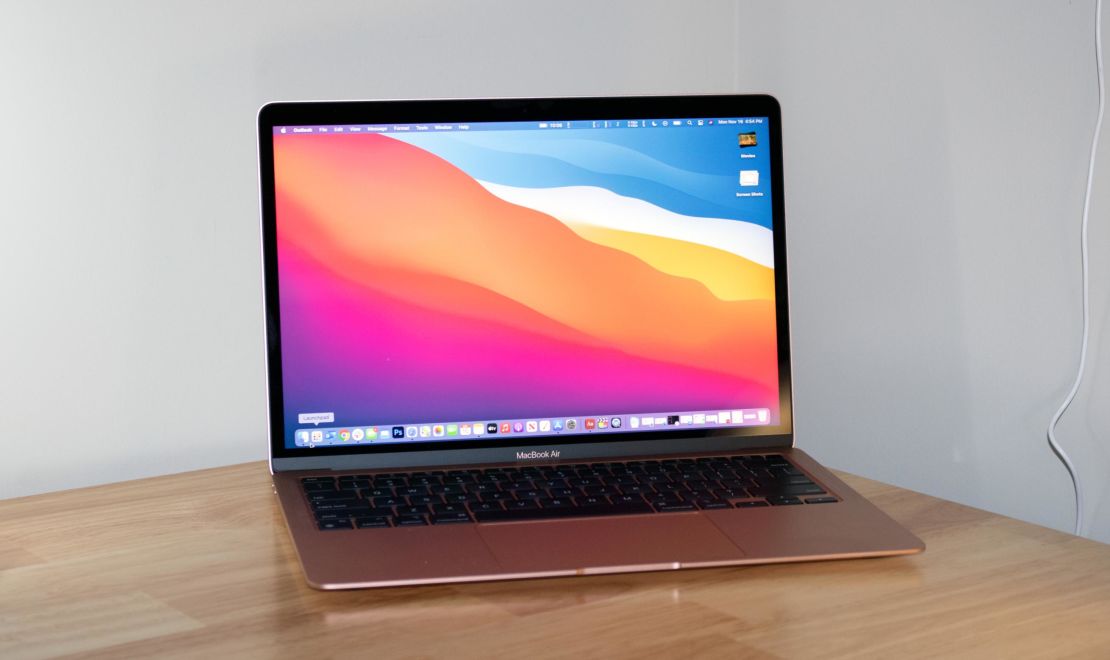With the arrival of the gorgeous new 24-inch iMac, Apple now has a full suite of compact and ridiculously fast computers powered by the company’s M1 processor. That begs the question: Do you go with the all-in-one convenience of the iMac, the portability of the MacBook Pro or Air, or the flexibility of the Mac Mini?
The good news is that all of these machines offer a similar amount of power — and you get a lot of it. Apple’s new M1 processor replaces the Intel chips found in older models, something we’ve found to deliver a major increase in performance in our testing. The big difference is that the MacBook Pro, Mac Mini and iMac get the added bonus of a fan, which can keep things a bit cooler (if occasionally louder) than the fanless MacBook Air.
Choosing between these similarly beastly machines can be tricky, but we’re here to make that decision easier for you. Here’s a breakdown of Apple’s powerful new laptops and desktops, and the kind of person each one is suited for.
iMac: For big-screen convenience at home ($1,299; amazon.com and bhphotovideo.com)

Apple’s new iMac is an all-in-one computer, meaning everything it needs to run is packed right into its incredibly slim display. It also comes with a keyboard and mouse, giving you everything you need to start working and playing right out of the box. So if you want a full computer experience within a big, vibrant screen that won’t take up much space, the iMac is likely for you.
At the center of the iMac is a 24-inch display that’s designed to make videos, photos and games look as vibrant and detailed as possible. It has the tech specs to back it up, with a super-crisp 4.5K resolution (4480 x 2520). That should make for a good canvas for doing intensive creative tasks, as the iMac has an Apple M1 processor that the company says can give you the ability to edit up to five streams of 4K footage in Final Cut Pro at the same time if you opt for the more powerful 8-core graphics processor option.
The iMac looks to be the best Mac in Apple’s lineup for video calls, packing a 1080p camera with advanced software smarts for making you look bright and true to life. By comparison, the MacBook Air and Pro sport a less-sharp 720p camera, and the Mac Mini requires you to provide your own webcam. Apple’s new desktop ships with a wireless Magic Mouse and Magic Keyboard, the latter of which comes in a choice of three different models depending on whether you want extra features like a Touch ID fingerprint scanner and a full numerical pad. Regardless, though, it will be color matched to your iMac along with the mouse.
While the latest Macs start with more overall storage at 256GB compared to 128GB for the previous generation, the new iMac is on the weaker side of Apple’s lineup when it comes to maximum space. Apple’s new desktop can be configured with up to 1TB of free space, which is notably less than the maximum of 2TB that the MacBook Pro and Mac Mini support. If you’re the type of person who works with lots of large photo and video files, the iMac could fill up fast if you don’t have a good external hard drive handy.
It’s also not the best overall Mac for connectivity, as Apple’s new desktop starts with just two USB-C Thunderbolt ports on the $1,299 model (which allow for very fast file transfers and seamless connectivity with external 4K displays), and maxes out with just four USB-C ports overall on the more expensive models. That’s slightly better than the latest 13-inch MacBook Pro (which comes with only two ports) but not quite as expansive as the mix of connections you’ll get on the Mac Mini. In the end, you’ll need to pay at least $1,499 for four ports.
Despite these drawbacks, the iMac has a lot to offer for folks who want a Mac with a big screen, a sharp webcam and a compact design that includes all the accessories you need to get up and running right away. Preorders for the new iMac start on April 30, and the desktop will start shipping in mid-May.
MacBook Pro: For lots of power on the go (starting at $1,149, originally $1,299; amazon.com, bhphotovideo.com and expercom.com)

As the highest-end laptop in Apple’s M1 arsenal, the 13-inch MacBook Pro has an obvious advantage over its desktop siblings — you can get a lot of demanding work done on it just about anywhere. That’s especially true of the latest 13-inch MacBook Pro, which is currently our favorite laptop for video editing, thanks to its blistering performance.
Apple’s latest MacBook allowed us to run more than a dozen demanding apps without a stutter and export large video projects in Final Cut Pro in mere seconds. And if you need a Mac for working on the go, know that the MacBook Pro’s battery held strong over long 14-hour days and stayed cool, thanks to that M1 chip. Complementing that strong endurance is the excellent Magic Keyboard, which we found to be much snappier and more comfortable than the shallow butterfly keyboards on older Macs.
The M1-powered MacBook Pro sports a 13.3-inch Retina display that delivers an immersive viewing experience with its 2560 x 1600 resolution. You obviously won’t get the same amount of screen space and sharpness as you will on the 24-inch iMac, but you’ll still get the same luminous 500 nits of brightness and the same True Tone technology for making colors look natural in any environment.
Like the iMac, the newest MacBook Pro is a bit lacking when it comes to ports, with just two Thunderbolt connections. You can get four ports on the older MacBook Pro 13-inch as well as the 16-inch model, but both of those Intel-powered laptops lack the sheer muscle of the M1 chip.
If you don’t mind giving up a bit of connectivity (or don’t mind picking up a USB-C hub to expand your port options), the MacBook Pro is the way to go for folks who need to crank through demanding tasks both at home and on the road.
MacBook Air: For great performance and portability (starting at $899, originally $999; amazon.com, bhphotovideo.com and expercom.com)

The MacBook Air isn’t just the most travel-friendly laptop in Apple’s lineup — it’s also one of the most powerful computers the company has ever released, period. Despite a svelte design that’s just 0.63 inches slim and 2.8 pounds, the MacBook Air taps into the M1 processor to deliver speeds that are nearly on par with its older sibling in the Pro. Combine that performance with a relatively inviting starting price of $999, and you can see why it’s our pick for the best Apple laptop.
Apple’s slimmest laptop allowed us to crank up 16 programs at once (including Final Cut Pro and Photoshop) without any slowdown, and gave us blistering video export speeds that rival the Intel-powered 16-inch MacBook Pro. And the Air’s battery life is stellar, lasting us nearly four solid days of on-and-off use before we had to plug it in.
Display-wise, you’re getting the same gorgeous 13.3-inch Retina display found on the MacBook Pro, complete with a sharp 2560 x 1600 resolution for getting lost in movies or seeing spreadsheets clearly. The Pro is rated for higher brightness, however, at 500 nits versus 400 nits for the Air. And if you spend most of your time in Photoshop, remember that the MacBook Air meets the P3 Color Gamut standard.
The MacBook Air also shares the MacBook Pro’s 720p webcam, which took sharp photos in our testing but isn’t quite as high-resolution as the 1080p camera in the iMac. You’ll get the same excellent Magic Keyboard as the Pro offers, and like on the M1 MacBook Pro, you’ll be limited to just two Thunderbolt ports.
Unless you want the absolute most power available in an Apple laptop (the MacBook Pro benefits from more maximum graphics performance and a fan for staying cool), the MacBook Air is a no-brainer for those who want a slim, highly portable notebook with great speeds and endurance. We think it sets a new standard for performance in the laptop category.
Mac Mini: For the DIY user who wants maximum flexibility ($669; amazon.com, bhphotovideo.com and expercom.com)

If you don’t mind a bit more setup work, the Mac Mini offers a ton of power inside a versatile and compact design. This miniature desktop takes the form of a small 8-inch-by-8-inch hunk of metal that should fit easily into just about any desk setup or entertainment area, but you’ll need to connect your own mouse, keyboard and monitor to get everything up and running.
The Mac Mini is technically the most affordable member of the Mac family, with a starting price of $699 with 256GB of storage. That price goes up when you factor in peripherals (the wireless Magic Keyboard and Magic Mouse start at $99 each), but you can also use it with many of the accessories and displays you may already have lying around.
As you might expect, the Mac Mini features the same M1 processor as the new iMac, MacBook Air and MacBook Pro, so you can expect lots of multitasking power for churning through video edits, doing some music production or firing up the latest Apple Arcade games. It also has the most configurable storage of the lineup, as you can outfit it with up to 2TB of space upon purchase (if you’re willing to pay a hefty $600 for the upgrade, that is).
Aside from its compact size and range of storage options, the Mac Mini really stands out among the Mac family with its port selection. The latest model gets you two Thunderbolt USB-C ports, two USB-A ports for older accessories, an Ethernet port for wired internet and an HDMI 2.0 port for connecting to displays. This gives you much more versatility for plugging in mice, keyboards, storage drives and monitors without having to spring for a USB dongle or hub.
The obvious drawback of the Mac Mini is that, unlike the iMac and MacBook Pro, this desktop requires a bit of do-it-yourself effort before you can get started. But if you don’t mind bringing your own accessories to the party, the Mac Mini is one of the most versatile Macs you can buy.
Bottom line
There’s never been a better time to buy a Mac. Apple’s latest lineup of laptops and desktops is both sleeker and more powerful than ever, and there’s no real wrong choice between the iMac, MacBook Pro and Mac Mini. It really just depends what your needs are.
The latest iMac is ideal for folks who want a big, stationary screen for hopping on work calls or watching movies, while the MacBook Pro and MacBook Air let you take things on the road with great battery life and within highly portable designs. And if you want a compact computer that you can use with any monitor, mouse and keyboard you like, the Mac Mini’s versatility is hard to top.
Better yet, all of these computers are powered by Apple’s new M1 processor, which means lots of power for tearing through demanding tasks (and kicking back with some gaming when you’re done). No matter which one you choose, you’ll be treated to the speediest, most efficient Mac experience currently available.




















